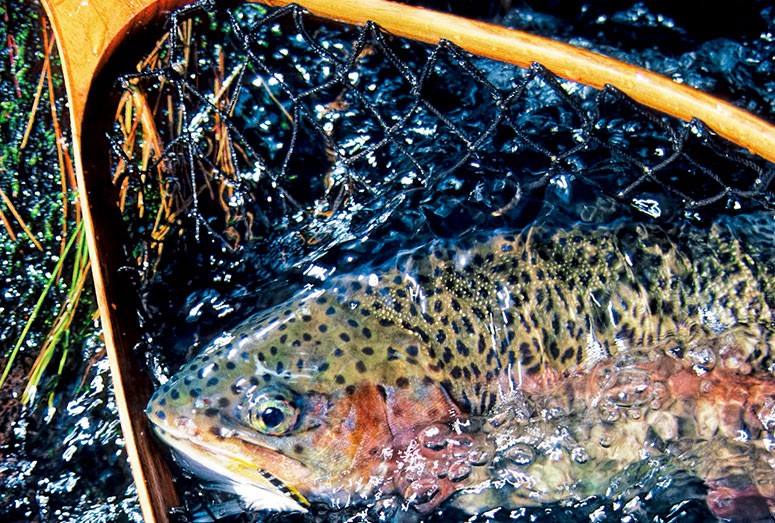Wild at Heart
Six alumni who work with animals share their favorite tips, tales and tricks of the trade.
Read The StoryProfessor of Political Science David Rowe muses on the beauty of fly-fishing.

The waning sun filtered through the red and yellow foliage on the last warm day in October. I was fly-fishing in a favorite stretch of the Kokosing River, not far from campus. Behind some trees, across the flood-plain, Old Kenyon’s spire pinpricked the sky. The river here makes a sharp turn as it hits a rocky bank, falls back on itself, and carves a deep, green channel with all the elements of abundant aquatic life — moving current, well-oxygenated water, depth, and the many rocks and snags that provide shelter and ambush in the Darwinian drama that brings fish and fishermen to this place.
I often catch fish here, but this day was exceptional. Nearly every cast brought an electrifying jolt as a fish took the fly: a surge of adrenaline as the fish, discovering the deceit that its meal was a cruel hoax of feather and hook that turned predator into prey, fought relentlessly against the line as I worked it back to me. The fish that afternoon were all large, strong and well-fed, bulking up for the coming winter. They were beautiful.
I left the water exhilarated — rarely is fishing this good. God’s grace in the New Testament often appears as a bountiful harvest of fish, an undeserved gift from an unseen world. But my mood was tempered by loss. Two years earlier, adulthood took my longtime fishing companion away from home. My son and I fished this very water the day before he left for college. I called him to talk. “What is it you miss?” I asked. “The chance to think,” he replied, refusing the bait. Sons must shake free from their fathers.
Fly-fishing naturally encourages contemplation. The solitude and quiet that accompany a fisherman on the water provide a respite from the hustle of the daily grind, a haven in which to examine life, to think deep thoughts. Socrates could have been a fly fisherman. It is also why fly fishermen can themselves be preening and overbearing, dripping with literary condescension and liberal-artsy snobbery. After all, the float that a fly fisherman uses to detect the ever so subtle strikes made by ever so cultured but discriminating fish (the ones that pair best with a crisp, dry Riesling, ideally served with saffron-scented rice) is not the working-class “bobber,” but the gentlemanly “strike indicator.” Some of mine are made from the finest New Zealand merino wool.
To fly fish well does require an acute awareness of the natural world and one’s place in it. One must read the water, see beneath its surface, translate subtle differences in flow and current into a mental structure of a world unseen, link the organisms that occupy that world — predator and prey — into a complex, interconnected web of life, and comprehend that world through the eyes and needs of another. All to catch a fish. One is never far from the uncomfortable truth that fly-fishing, from the perspective of the fish, is invariably cruel. A blood sport.
I learned to fish as a young boy from my father, an avid outdoorsman and ranger for the National Park Service. He had been an infantryman in the European theater of the Second World War, spending much of his time, I later learned, in the no-man’s-land between the front lines, part of a reconnaissance unit tasked to make contact with the enemy. I once asked him why he taught me to fish but not to hunt. “I just can’t shoot anymore,” he said.
I still remember our first fishing trip. We lived in northern New Mexico, at the bottom of a canyon where the high desert becomes the Rocky Mountains. It was a dusty world of sheer, red sandstone cliffs looming over a thin ribbon of life lined by cottonwoods on the canyon floor. Up in the backcountry, the creek was so narrow at points that even as a boy, I could jump it.
My father woke me early one morning as my brothers slept. We hiked along the creek, up into the backcountry, until we reached a spot where the canyon floor flattened and the creek slowed, hidden behind a wide bed of reeds. We got down on our hands and knees, quietly pushing the reeds aside as we stealthily worked our way to the stream’s edge.
The creek here flowed over a small shelf, creating a deep, quiet pool. Peeking out from our cover, I saw live trout for the very first time. Directly beneath us were four or five trout, pale shadows, nearly invisible against the sandy tan of the creek bottom, shimmering in and out of existence, first there, then not, as the water rippled over them. My father dropped the line directly in front of the first shadow, and, in a skill I have never mastered, twitched it, inducing the trout to strike and miss. He then dropped the line in front of the trout once more, provoking an immediate and vicious attack.
The creek exploded. The pale shadows flitted away. All except one. My father held in his hand a sleek, stream-lined, iridescent creature with a bold red stripe against a light green background along its flank, fading to silver-white along its belly. A shadow transformed.
It was beautiful.
Six alumni who work with animals share their favorite tips, tales and tricks of the trade.
Read The StoryEnglish professor (and dog lover) Jim Carson probes the significance of animals in literature, drawing on insights…
Read The StoryDrama cats. Presidential dogs. A flock of peacocks. Meet some of Kenyon's most beloved residents.
Read The StoryA conversation between Laura Hillenbrand '89 H'03 and Julie Barton '95.
Read The Story